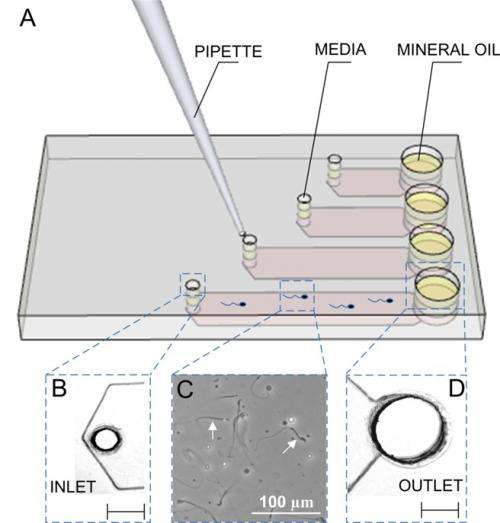Researchers develop sperm-sorting design that may aid couples undergoing in vitro fertilization

(Medical Xpress)—According to the World Health Organization, approximately 70 million couples experience infertility worldwide. Current data suggests that nearly one third of infertility disorders are due to poor sperm quality. For couples undergoing in vitro fertilization, certain sperm characteristics, such as motility and stamina, are crucial when sorting and selecting sperm. However, selecting the fittest sperm can be a challenge.
Now researchers at Brigham and Women's Hospital (BWH) have developed a simple and cost-effective design for sperm sorting, in which healthy, motile sperm can be effectively separated by space-constrained microfluidic sorting chips.
The study was published online this month in the science and technology journal Small.
According to the researchers, the chip design was inspired by nature. In the female, sperm naturally must swim through the cervical mucus in the cervical canal to reach and fertilize an egg. The pathway that the sperm must swim is akin to a microfluidic channel, since sometimes mucus on the walls of the vagina become watery and form tiny microchannels that guide the sperm through to the egg.
Based on this naturally occurring phenomenon, the researchers developed a microfluidic design at the length and scale of channels in which sperm could successfully swim towards the egg.
"These bioinspired microfluidic devices create tiny corridors for cells at the size scale comparable to their own allowing them to interact with their surroundings and each other," said Utkan Demirci, PhD, assistant professor of medicine and health sciences and technology at Harvard University Medical School, Brigham and Women's Hospital, principal investigator for BWH Bio-Acoustic Mems in Medicine Laboratory, senior study author. "This enables applications, such as cell sorting, by controlling their microenvironment."
The researchers tested their design using human and mouse sperm—employing computational models to assess the movement of sperm as they navigated their way through various channel lengths.
Measuring the effects of exhaustion time of sperm, they found that mouse sperm had an average exhaustion time of 30 minutes during incubation. On the other hand, human sperm were at their highest motility for up to one hour of incubation when swimming in a 20 millimeter channel.
"These inexpensive devices sort sperm without any sample handling," said Demirci. "This has the potential to lead to unique and simple strategies for home-based sperm testing especially if we are able to integrate this with existing technologies such as cellular phones and cameras."
In terms of extending the technology's use beyond infertility treatment, Savas Tasoglu, PhD, BWH Bio-Acoustic Mems in Medicine Laboratory, the study's first author adds, "This technology can also be helpful to preserve sperm of endangered species, where access to samples is challenging in the wildlife."
More information: onlinelibrary.wiley.com/journal/10.1002/%28ISSN%291613-6829

















